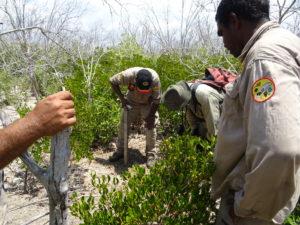Keywords: Gulf, Gulf of Carpentaria, Gulf Country, mangrove, unprecendented mangrove dieback, dieback, blue carbon, carbon sequestration, dead mangroves, shoreline retreat, mangrove retreat, berm build up, berm build-up, ecosystem services, ecosystem cycles, aquatic food chains, trophic chains, trophic food webs, trophic foodwebs, ecological disturbance, carbon accounting, carbon sequestration, report cards, environmental report cards, environmental grades, Dr Norm Duke, Dr Duke, Professor Lindsay Hutley
Hub research in the Gulf of Carpentaria aims to support sustainable development in the region. This includes research to inform water allocation planners and floodplain managers about the potential impacts of changes in flow on fisheries, migratory birds and biodiversity. Rivers that flow into the southern Gulf of Carpentaria are home to high-value ecosystems and support important recreational and commercial fisheries. With increasing development in the region, more information is needed to understand how future water development will impact on the health and productivity of floodplains and coastal areas.
Australia is home to 7% of the world’s mangroves, mostly located in the tropics. During the summer of 2015-6, one of the worst mangrove dieback events ever recorded devastated around 7400 hectares of mangroves along more than 1000 km of Gulf of Carpentaria coastline. This project produced a field guide for Indigenous rangers to monitor mangrove condition in the Gulf.
The project was led by Professor Norm Duke from James Cook University (JCU). Professor Duke was assisted by additional researchers from JCU and Indigenous ranger groups in the region.

Mabunji Rangers assisting with field surveys in the NT.
For more information, visit the Mangrove Research Hub and Australian Mangrove and Saltmarsh Network websites. Survey data is available at eatlas.org.au
Contact
Norm Duke, James Cook University
norman.duke@jcu.edu.au
0439 191 952
This project is also being supported by the Tropical Water Quality Hub, the Marine Biodiversity Hub and the Earth Systems and Climate Change Hub of the Australian Government’s National Environmental Science Program.